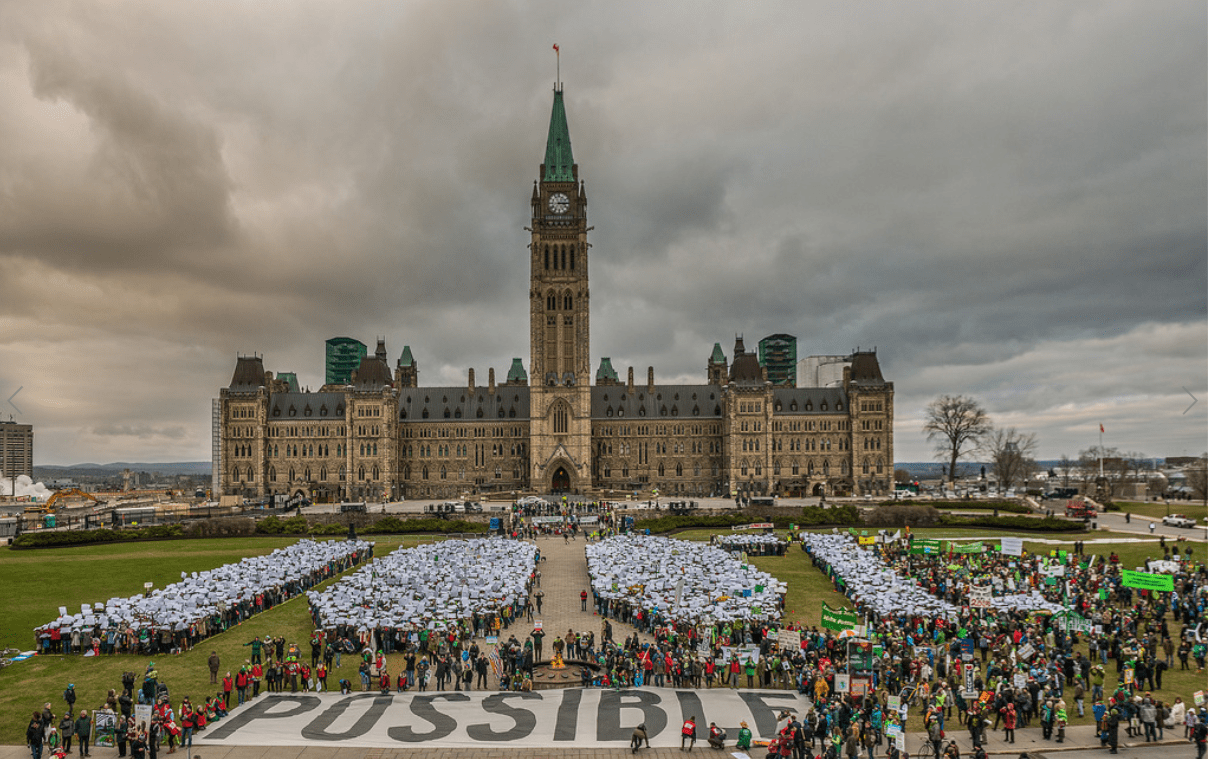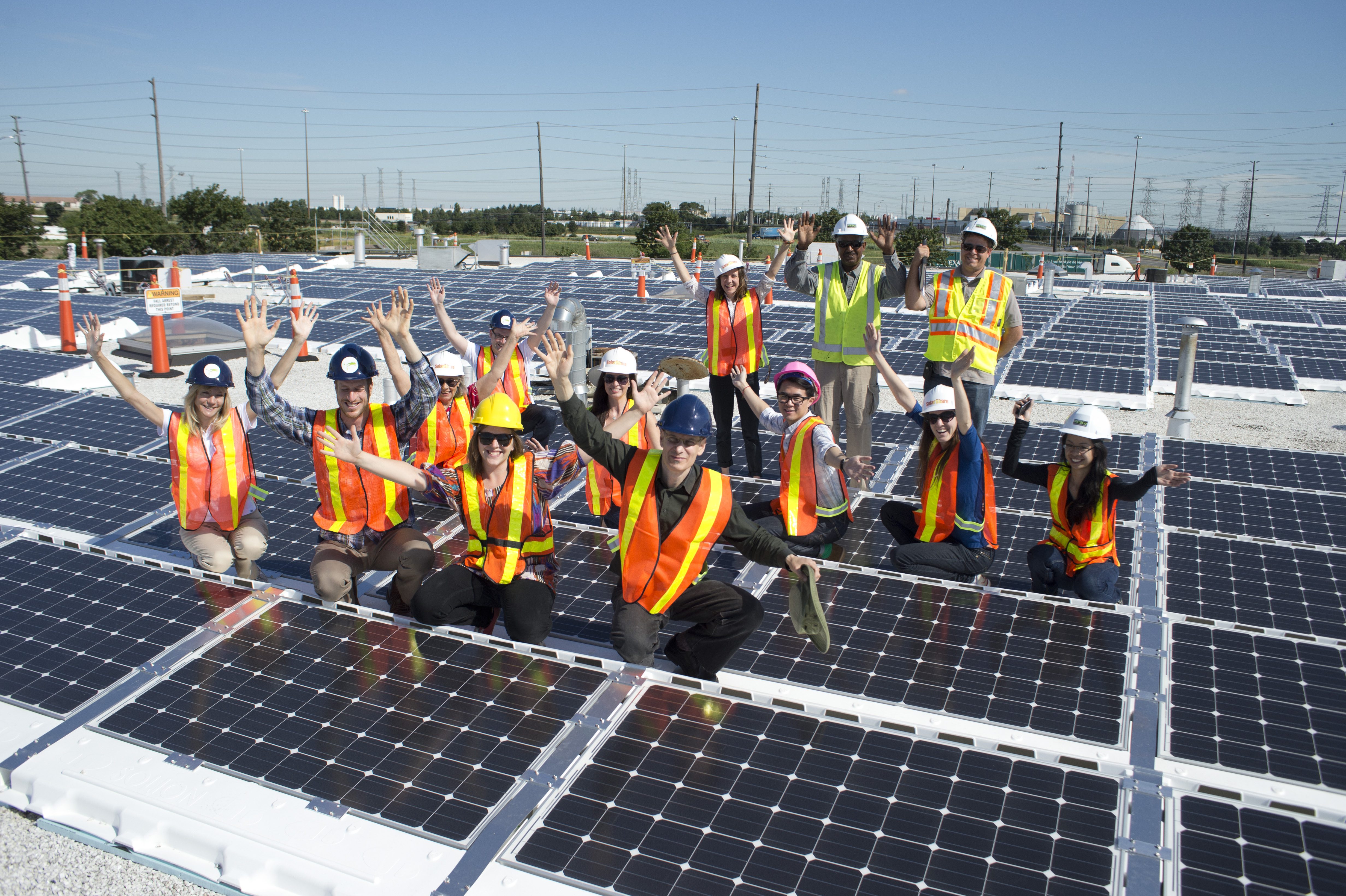With winter approaching, it’s a good time to look back at what we’ve achieved together over the past year. And what a busy year it was! For several weeks, we’ve been highlighting on our blog recent environmental victories your support made possible. For a more detailed list of victories, check out our 2016 Annual Report. In the meantime, below is a snapshot of recent victories in our work to defend a safe climate and build a clean economy.
URGING FEDERAL CLIMATE ACTION
This year we encouraged the new federal government to become a climate leader. Ahead of the UN Conference of the Parties (COP21) in Paris, we issued a report outlining how Canada could be a constructive partner in the fight against climate change. Just before COP21, we – along with thousands of others, including First Nations, business, labour, and faith communities – participated in the 100% Possible March in Ottawa. I spoke at the march, urging elected officials to take bold climate action.
 In Paris, a member of our team was on Canada’s official delegation, advising government and urging for an ambitious agreement. During COP21, our spokespeople were interviewed by nearly every major news outlet in Canada. When the Paris Agreement was finalized in December and signed in March, we celebrated the first global accord to fully acknowledge the science of climate change. The Paris Agreement commits the world’s governments to aim to keep global warming to 1.5 degrees and adopts the long-term goal of making the planet carbon neutral in as little as 35 years.
In Paris, a member of our team was on Canada’s official delegation, advising government and urging for an ambitious agreement. During COP21, our spokespeople were interviewed by nearly every major news outlet in Canada. When the Paris Agreement was finalized in December and signed in March, we celebrated the first global accord to fully acknowledge the science of climate change. The Paris Agreement commits the world’s governments to aim to keep global warming to 1.5 degrees and adopts the long-term goal of making the planet carbon neutral in as little as 35 years.
In March, the federal government and the provinces agreed to develop a climate framework for Canada. We worked with others to develop proposals, such as on putting a price on carbon pollution, which would make the framework strong and ambitious. In October, Prime Minister Justin Trudeau announced that there would be a pan-Canadian price on carbon, and that the framework would be finalized and unveiled in December.
At COP22 in Marrakech, Canada’s role was mixed. We continue to urge the Canadian government to take meaningful climate action. Canada is far from its 2020 carbon reduction target. It’s time for Canada to step things up, by committing to achieve the 2030 reductions entirely at home, with a view to reducing emissions even further.
SUPPORTING PROVINCIAL CLIMATE ACTION
 Strong federal climate action is needed, but effective action from provinces is also essential. At COP21 in Paris, we celebrated provincial climate leadership with an event where premiers from Ontario, Quebec and Manitoba and ministers from British Columbia and Alberta spoke on the importance of climate action.
Strong federal climate action is needed, but effective action from provinces is also essential. At COP21 in Paris, we celebrated provincial climate leadership with an event where premiers from Ontario, Quebec and Manitoba and ministers from British Columbia and Alberta spoke on the importance of climate action.
In the spring, we welcomed and supported the importance of the Vancouver Declaration, where the country’s federal and provincial leaders agreed Canada should support the UN Paris Agreement, that governments should meet Canada’s existing carbon reduction targets, that greater levels of ambition are needed, and that putting a price on carbon is an essential tool for climate action.
We also highlighted the historic nature of Alberta’s climate action plan for committing to shut coal plants, increase renewable energy, put a price on carbon, cut methane emissions from oil and gas and put a legislated cap on tar sands emissions. The cap means emissions from Alberta will soon peak and then we can plan for their decline. This removes one of the largest barriers to climate action in Canada.
Want to power more victories like this? Donate to Environmental Defence and help defend a safe climate, clean water and healthy communities!
 Over this past year, we continued to grow the Clean Economy Alliance (CEA), a group of nearly 100 organizations united to support Ontario in addressing climate change. This year the CEA helped shape two landmark plans for the province to address climate change: Bill 172, which enacts pricing carbon through a cap-and trade system, legislates ambitious carbon reduction targets and commits the proceeds from cap-and-trade to programs to further cut carbon emissions; and the Climate Change Action Plan, which outlines complementary policies and programs to reduce carbon pollution, many of which cap-and-trade will fund. Throughout the year, we encouraged Ontarians to tell the province they support bold climate action and building a clean economy.
Over this past year, we continued to grow the Clean Economy Alliance (CEA), a group of nearly 100 organizations united to support Ontario in addressing climate change. This year the CEA helped shape two landmark plans for the province to address climate change: Bill 172, which enacts pricing carbon through a cap-and trade system, legislates ambitious carbon reduction targets and commits the proceeds from cap-and-trade to programs to further cut carbon emissions; and the Climate Change Action Plan, which outlines complementary policies and programs to reduce carbon pollution, many of which cap-and-trade will fund. Throughout the year, we encouraged Ontarians to tell the province they support bold climate action and building a clean economy.
OPPOSING RISKY PIPELINES
 As we push for a transition to a low-carbon economy, we continue to raise awareness about risky pipelines like TransCanada’s Energy East proposal. If built, Energy East would put nearly 3,000 lakes, rivers and streams at risk of tar sands oil spills. With current technology, carbon emissions associated with producing oil for Energy East would exceed the proposed emissions cap in Alberta and risk breaking Canada’s Paris climate commitments.
As we push for a transition to a low-carbon economy, we continue to raise awareness about risky pipelines like TransCanada’s Energy East proposal. If built, Energy East would put nearly 3,000 lakes, rivers and streams at risk of tar sands oil spills. With current technology, carbon emissions associated with producing oil for Energy East would exceed the proposed emissions cap in Alberta and risk breaking Canada’s Paris climate commitments.
In Ontario, we partnered with local groups for a travelling photo exhibit, Along the Pipeline, featuring portraits of people at risk from Energy East. We also launched the website SaveFundy.ca, highlighting threats Energy East tankers would pose to the Bay of Fundy.
In the spring, we and our allies published the report, Energy East: A Threat to Our Drinking Water, which showed that the pipeline would threaten the drinking water of more than 5 million Canadians. And we continued to help Canadians to speak out against the risks of Energy East.
In June, ENVIRONMENTAL DEFENCE was approved as an official intervenor in the National Energy Board’s (NEB) process to review Energy East. The hearings had barely started when the NEB’s backroom meetings with TransCanada lobbyists were revealed. We joined more than 50 environmental groups to call for the resignation of the panel members and the cancellation of the Energy East review. The panel members were forced to recuse themselves, putting the review in limbo. We will continue to push the federal government for the long-promised overhaul of the NEB; the Energy East review can only restart after Ottawa reforms the discredited regulator.
NEXT STEPS:
While we’re pleased with the progress in the last year, there is still a lot of work ahead before action in Canada matches the scale of the climate challenge:
- We’ll be working to encourage a strong and effective national climate strategy. We will continue to encourage Canada and the provinces to build a clean economy, powered by safe, modern renewable energy.
- We know that greater action is possible, and that Canada can not only meet our 2030 carbon reduction targets, but go even further. We will continue to push for strong action now, and greater ambition over time.
- We, along with the Clean Economy Alliance, will support and monitor the implementation of cap-and-trade in Ontario and the Climate Change Action Plan’s roll out.
- We’ll also recommend how to improve Ontario’s Long Term Energy Plan (which the province is reviewing) and push for more energy from renewable sources. And we’ll release a report on how energy efficiency programs benefit the environment and create green jobs in Ontario.
- When the NEB’s review of the Energy East pipeline resumes, we will be an official intervenor in the hearings.
- We’ll continue collaborating with other groups to build opposition to Energy East and highlight its threats to our communities, land, air and water. And we’ll be sure to let you know how you can make your concerns heard.
- We’ll also continue working to reform and strengthen Canada’s environmental laws and processes that have been weakened to allow risky energy projects to move forward.
Want to see more victories like the ones described above? Donate to Environmental Defence and help power our work to protect Canadians’ environment and human health.
Sign up here for updates and action alerts on climate change, and our work to build a clean economy








